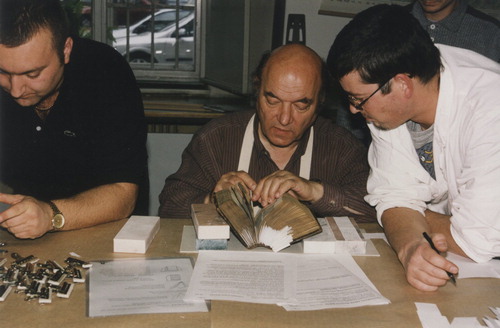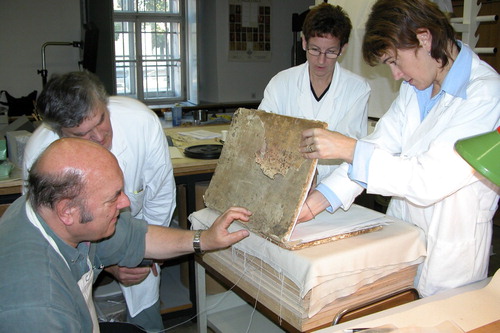ABSTRACT
Christopher Clarkson's teachings, innovations and numerous publications had a profound effect on understanding book structures. However, his main contribution was undoubtedly that of abandoning the rebinding practice based on bookbinding traditions until the twentieth century, in favour of expertise and scientifically grounded principles of modern book conservation. Clarkson trained and mentored many conservators worldwide, including some from Slovenia. He was engaged by the Book and Paper Conservation Centre of the Archives of the Republic of Slovenia in Ljubljana eight times to teach book conservation. The participants not only began to understand Clarkson's conservation theories and principles, they also began to fully adopt his book conservation methods.
ZUSAMMENFASSUNG
Christopher Clarksons Lehren, Innovationen und zahlreiche Veröffentlichungen hatten einen tiefgreifenden Einfluss auf das Verständnis von Buchstrukturen. Sein größter Beitrag bestand jedoch zweifellos darin, die bis ins 20.Jahrhundert reichende Buchbindetradition des Umbindens zugunsten fachkundiger, wissenschaftlich fundierter Prinzipien der modernen Buchkonservierung aufzugeben. Clarkson schulte und betreute viele Restauratoren weltweit, darunter auch einige aus Slowenien. Er wurde achtmal vom Buch- und Papierkonservierungszentrum des Archivs der Republik Slowenien in Ljubljana engagiert, um Buchkonservierung zu unterrichten. Die Kursteilnehmer begannen nicht nur Clarksons Konservierungstheorien und -prinzipien zu verstehen, sondern fingen auch an, seine Methoden zur Buchkonservierung vollständig zu übernehmen.
SCHLÜSSELWÖRTER:
Introduction and background
In the late 1960s and early1970s Christopher Clarkson sought to present a new discipline — book conservation — that would break with the nineteenth- and twentieth-century trade bookbinding practices. In working towards that goal, he began to develop high quality book conservation training courses, convince management that book conservation was important, and work with suppliers to develop high quality book conservation tools and supplies. Clarkson believed the best way to make progress was by providing staff training within their employing libraries and archives. He felt it was essential to design that training to achieve a balance between academic and the practical needs. In his experience, Christopher Clarkson found his most successful conservation classes were two-week sessions, based on one specific historic bookbinding structure. The purpose of each workshop was not to simply construct a historic binding model, but instead to study specific binding features, functions and significant details. Each binding structure was chosen for its ability to illustrate characteristics that facilitated preservation of its materials and structure. Clarkson's teaching style encouraged students to ask questions and start discussions during his classes. His responses often included illustrations of historical, technical or conservation aspects of a material, function or structural feature (Clarkson, Citation1978: 33–34).
During his 40 plus year career, Christopher Clarkson devoted himself to the study of book conservation. Due to his vast book conservation knowledge and his teaching talent he was frequently engaged by cultural institutions and conservation centers to increase their knowledge about book conservation. The Book and Paper Conservation Centre of the Archives of the Republic of Slovenia (Slovenian National Archives) was among those institutions.
Christopher Clarkson — Book Conservation Teaching Methods
Christopher Clarkson's conservation career began to take off while he was a member of the first team of conservators that went to Florence Italy in 1966 to save flood damaged books and manuscripts. It was during this time that Clarkson began his research on limp vellum bindings. He was fascinated by the limp vellum binding structure because it survived the Florence flood so well. This style of binding was also an easy structure to preserve throughout the massive conservation treatments necessary because of the damage caused by the flood (Bell & Clarkson, Citation2001). After years of studying a wide variety of period bindings, Clarkson continued to consider the 1500–1525 limp vellum binding style as a positive development (Clarkson, Citation1982, 1; Bell & Clarkson, Citation2001: 81). Limp vellum bindings arose towards the end of a long period of creative bookbinding. In Clarkson's book ‘Limp Vellum Binding and its Potential as a Conservation Type Structure for the Rebinding of Early Printed Books’ he describes limp vellum bindings as the only type of binding, that, to the sensitive observer, could readily reveal flaws in both material and techniques. From his studies of limp bindings he determined that a rapid decline in materials and structures began to occur sometime during the sixteenth century (Clarkson, Citation1982: 4). Because of that decline, Clarkson decided that earlier sixteenth-century limp vellum binding styles were the best examples to use in training sessions (Clarkson, Citation1982, Citation1997–Citation2010: year Citation1999).
Codex construction before the era of printed texts was very diverse. At that time, one individual craftsman produced the entire codex, which created an engineering synergy, whereby the entire structure was designed to move as one unit. Generally high-quality materials were used during that period. In fact, these books not only worked well as whole units they also had a natural vitality, a spontaneity, which allowed the reader to easily open the binding without any strain. These early binding practices were initially carried on into the printed book period. Variations in codex binding styles began to be reduced to a few basic styles in the latter part of the sixteenth century (Bell & Clarkson, Citation2001: 80). We began to see features that suggest a greater division of labour, economies in the quality of the materials and shortcuts in techniques that reduced the book's ability to function. The term ‘book conservation’ started to be applied to book conservation activities by highly regarded professionals such as Peter Waters, Donald Etherington, Frazer Poole, and Christopher Clarkson. After the Florence flood, all of them started strictly to use this term in all their work, to show a distinct philosophical and practical break with the hand binding and trade craft traditions of the previous two centuries. It was Walters and Frazer who fought management at the Library of Congress for many years to change the office name from Restoration to Conservation. The word ‘conservation’ before the Florence flood was not used in connection with preserving library and archive collections but was only used for art and museum object conservation (Clarkson, Citation1978; Bell & Clarkson, Citation2001: 75).
The idea of books as containers for other objects (scrapbooks) also fascinated Clarkson. He often stressed that the codex format has proven itself, over the last 2000 years, to be the best available time capsule. If, in the future, materials and book structures are well designed, books will continue to preserve the original state of items that are placed inside it (Clarkson, Citation1997–Citation2010: year 2008).
Present day training in book conservation generally offers a limited number of bookbinding structures, techniques and material knowledge. Clarkson taught the importance of studying book functions, incorporating good engineering techniques, and sound material science to properly preserve books. Whenever extensive repairs, or intrusive rebinding, takes place, the diverse binding structural heritage of individual countries and periods is being diluted, changed or even lost (Clarkson, Citation1999: 89–96).
Underlying many of our problems, when considering special collections in archives and libraries, is the general lack of appreciation of the physical importance of the material nature of the collections. This is clearly exacerbated by the general reduction in scholarly and specialist staff, a growing problem that surely stems from the general reduction in humanity subjects within our University courses, a development that is already clearly reflected in the management of our institutions. (Clarkson, Citation1997–Citation2010: year 2010)
Christopher Clarkson — how book conservation training began in Ljubljana
In January 1995 Christopher Clarkson was the first to confirm his participation at the ‘Book and Paper Conservation’ international conference that was to be held in Ljubljana, the capital of Slovenia in 1996. He accepted without asking about security concerns due to the war in Bosnia, which was a concern for many others. The conference was organized to celebrate the fortieth anniversary of the Book and Paper Conservation Centre at the Archives of the Republic of Slovenia. Christopher Clarkson's contribution was a paper entitled, ‘The Safe Handling and Display of Medieval Manuscripts and Early Printed Books’ (Clarkson, Citation1997: 141–188) ( and ).
FIGURE 1. Christopher Clarkson during his presentation at the symposium ‘Book and Paper Conservation’, Ljubljana, June 4–5 1996. (Photograph: Dragica Kokalj).
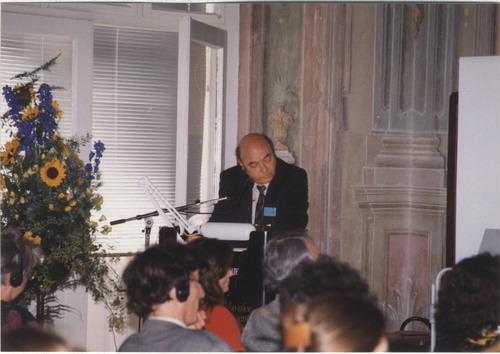
FIGURE 2. Christopher Clarkson during the symposium ‘Book and Paper Conservation’, Ljubljana, June 4–5 1996. (Photograph: Dragica Kokalj).
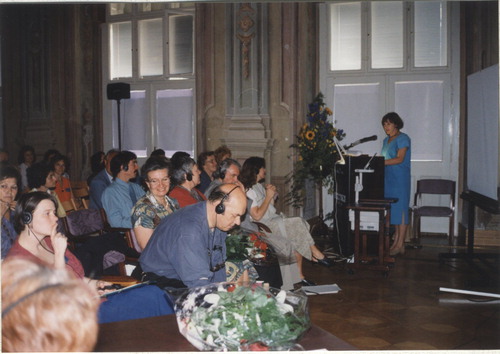
The institution's original intention was to further develop staff knowledge of book and paper conservation through practical training workshops. It soon became clear that it would be easier to raise funds by hosting an international conference on book and paper conservation. It was a great success. That success convinced Vladimir Žumer, who was then the director of the Archives of the Republic of Slovenia, to support a practical book conservation training workshop, which was scheduled for the following year. Clarkson also agreed to present at this highly anticipated workshop. This workshop was the first in a series of eight two-week practical and theoretical workshops led by Clarkson and held at the Archives of the Republic of Slovenia.
Additional events such as Clarkson's public lectures: Florence Flood 1966 in 1997, Hereford Cathedral's Mappa Mundi and Chained Library in 1999, Conservation of a Highly Illuminated Bible in 2000, The Monastery of St. Catherine in Sinai: Manuscript Collection and the Discovering of Ms. Syriac 30 in 2002, The Permanent diplay of the Single Parchment Membrane in Fluctuating Environmental Conditions: From Small Charter to the Mappa Mundi Ljubljana symposia in 2003, Minimum Conservation Intervention on Written Heritage in 2005 and Book Binding Technique from the Birth of the Codex to the Early Renaissance in 2008, and in house lectures and interviews for newspapers and TV Slovenia were also scheduled (Golob, Citation1998; Planinc et al., Citation2001).
In 2010 Chris Clarkson was asked by the Croation Conservation Centre in Zagreb to prolong his stay for some days and come to Zagreb for the conservation intervention on the Giulio Clović painting on parchment.
Christopher Clarkson training courses held in Ljubljana from 1997 to 2010
All the eight workshops were intended for staff and designed to relate to the host institution's collections. The workshops explored the social and technical aspects of historic binding structures and the materials used to make those books. In addition to exploring historic aspects, Clarkson discussed the quality of currently available materials and recent technical book conservation innovations of an ever growing field.
In addition to practical demonstrations, Christopher Clarkson discussed historic materials and tools and gave public lectures. Instead of having the class simply recreate historic bookbinding models, Clarkson discussed the best techniques used during the Romanesque period (ca. 1000–1200 AD) because of its highly refined western bookbinding techniques; from an engineering, scientific and mechanical perspective. He then had students replicate those techniques (Bell & Clarkson, Citation2001: 81; Clarkson, Citation2007: 87). Clarkson wanted participants to appreciate how interrelated each element of the book was to the movement of the whole three-dimensional object. Each replica was designed to supply participants with a wide pool of information and techniques as well as a greater understanding of how to plan conservation projects for period bindings. The eight training sessions and the two international symposia held in Ljubljana, positively enhanced the book conservation knowledge of staff within its cultural institutions.
1997, October 20–30: late Medieval stiff-board bookbinding construction
The first workshop, held in 1997, dealt with conservation principles and practices based on late medieval stiff-board bookbinding techniques. This course began by discussing evolutionary features of modern European bindings, and specifically dealt with features such as convex spines, backing shoulders and over-lapping boards. During these sessions we concentrated on a binding type that Clarkson considered a highpoint in book history because it was able to solve many binding problems. By discussing the reasons why this binding type was a highpoint, Clarkson hoped students would not only gain an understanding of historical techniques, but also appreciate its aesthetics and the reasons why specific techniques used to create modern stiff-board bindings would prove more successful ( and ).
FIGURE 3. Christopher Clarkson students from the Archives of Slovenia and National and University Library in Ljubljana, during the first workshop ‘Late Medieval Stiff-Board Bookbinding Construction’ in 1997. (Photograph: Dragica Kokalj).
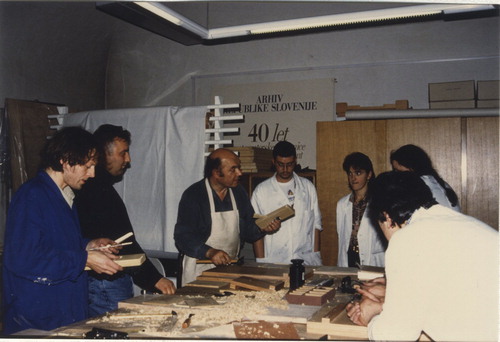
FIGURE 4. Christopher Clarkson with students-participants from the Archives of Slovenia and National and University Library in Ljubljana, during the first workshop ‘Late Medieval Stiff-Board Bookbinding Construction’ in 1997. (Photograph: Dragica Kokalj).
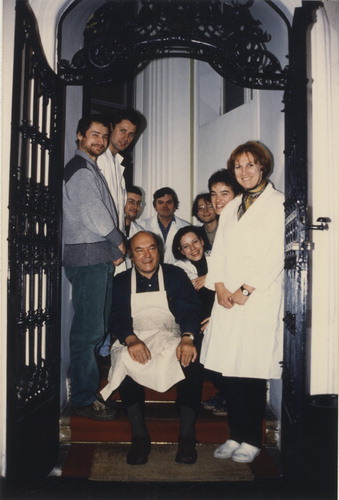
During his stay in Ljubljana, Dr. Nataša Golob interviewed Christopher Clarkson for Radio Slovenia. This interview is available in print and oral versions (Golob, Citation1998: 87–93). The audio file has been released by the Radio Slovenia for this publication (Zor & Clarkson, Citation2008).
1998, November 30–December 11: limp vellum bindings
The second workshop focused on limp vellum bindings, Clarkson's favourite structure. This type of binding is not easy, but Clarkson decided it was important for our group (Clarkson, Citation1982, Citation1997–Citation2010: year 1998). Parchment, being inherently hydroscopic, has difficulty retaining its shape and depending on the type of animal skin and techniques used to turn the skin into parchment, can make it hard to manipulate. In addition, to parchments's inherent problems, limp vellum bindings are not appropriate to use as a conservation treatment for every period book.
Many hundreds of limp and semi-limp vellum bindings were handled during the Florence flood, the earliest of which were found to have survived better than many other forms of bookbinding structures. This is a binding type, not for beginners, but for masters and will thus tax your understanding, concentration, technical abilities, luck and imagination. Therefore, do not expect me to train you with neat recipes, this is a teaching exercise, stretching the mind and skills which will inevitably lead to a certain amount of frustration, but hopefully lift you onto other levels of experience and understanding. (Clarkson, Citation1997–Citation2010)
1999, November 8–19: minimum conservation interventions in treatment of parchment and books
Minimum intervention means minimal interference, but paradoxically, books might need treatment. Therefore, a book conservator needs to acquire considerable knowledge and experience before attempting any intervention. During this workshop two themes were addressed:
‘Parchment — its nature, behavior, care, repair, housing and mounting’ and
‘Book conservation — minimum intervention, assessing condition, structural consideration, alternative methods of stabilization and repair’.
We were each working on items from our institutions. We began with, ‘Parchment — joints and repairs’. We also gathered for formal lectures, an introduction to condition analysis, documentation techniques, and had class discussions about interesting problems that occurred during the workshop. We studied a selection of sixteenth and nineneteenth-century damaged bindings and discussed the options we had for stabilization and repair of those structures (Clarkson, Citation1997–Citation2010: year 1999) ().
2000, October 16–27: housing and mounting of single parchment skins and design and construction of protection for library and archive objects
As in the previous workshops Clarkson started with an illustrated lecture, describing good and bad design. He also described book construction techniques to use depending on circumstances and situations within libraries and archives. This was followed by exercises designed to practice techniques and skills that were required for housing and mounting projects. We were divided in two groups. For the first week one group was making boxes while the other mounted single sheets. In the following week the groups switched tasks ( and ).
FIGURE 6. Christopher Clarkson during the workshop ‘Housing and Mounting of Single Parchment Membranes and Design and Construction of Protection for Library and Archive Objects’ in October 2000. (Photograph: Lucija Planinc).
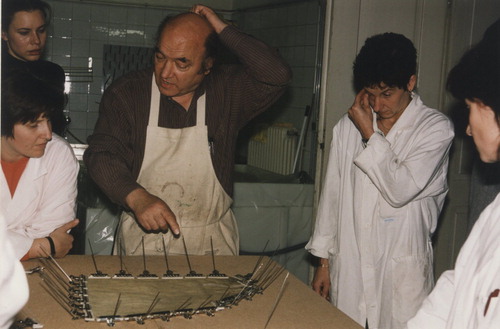
FIGURE 7. Christopher Clarkson during the workshop ‘Housing and Mounting of Single Parchment Membranes and Design and Construction of Protection for Library and Archive Objects’ in October 2000. (Photograph: Lucija Planinc).
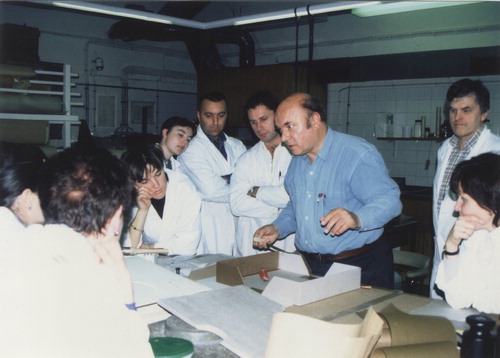
In addition to the workshop, Clarkson gave a public lecture on October 18, 2000, ‘Conservation of a Highly Illuminated Bible’ at the Faculty of Arts of the University of Ljubljana.
2002, November 18–29: the preservation and conservation of albums, scrapbooks, specimen books and throw-out guard books
Albums, scrapbooks, specimen books and throw-out guard books are abundant in libraries, archives and museums. These types of bindings are loosely related to one another in style, and often require similar book and paper conservation treatments. However, there is no specific classification for this style of binding. For the purposes of this article, they will all be referred to as scrapbooks. Scrapbooks are still constructed as a book, but in some cases even this description may be considered a stretch. There has been little interest in scrapbook conservation in the past 25 years, partially because the responsibility for conserving these objects falls somewhere between the book and paper conservation disciplines. Another more pressing problem is that there is a lack of knowledge about the historic significance of the structure and originator's intent, as well as, a lack of knowledge about the mechanics involved and tools necessary for making some scrapbooks. This lack of knowledge and tools has often led to a loss of artefactual integrity. Scrapbook structures range from commercially produced blank albums and books with paper or cardstock leaves to throw-out guard books where an individual can attach items such as letters, envelopes, printed ephemera, etc. to, personally designed scrapbooks and highly individualized collections of memorabilia. The contents of such books may be all of one type, i.e., a photographic album or correspondence or it can be a mixed media — ephemera. Mixed media or ephemera can include prints, photographs, watercolours, botanical specimens, samplers, letters, newspaper articles, etc. These books contain items that reflect a variety of ‘values’, personal, historic, financial, etc., which may or may not be interrelated. Because of the research value of individual pieces within a scrapbook, an institution may argue for a disbinding policy. However, many such collections are also unique personal records reflecting historic or social change in obvious or not so obvious ways. Whenever possible the artefactual integrity of the collection must be retained.
This workshop was designed to bridge those gaps by working within both the book and the paper conservation disciplines and with curatorial staff. The class discussed potential gains and losses when conserving or disbinding scrapbooks to develop more sophisticated treatment options.
The reality of the ‘time capsule’ maxim supports this claim. All these aspects that must be acknowledged and factored into decisions about a scrapbook's treatment proposal (Clarkson, Citation1997–Citation2010: year 2002).
2005, November 10–25: conservation of Medieval manuscript and incunabula
In 2004 we received a request from the Diocesan Archives of Maribor to treat of two of their most valued items from their rich collection of manuscripts and incunabula. This project was funded by the Ministry of Culture of the Republic of Slovenia. One object was a fourteenth century illuminated pontifical from the Bohemian environment, Ms 12, and the other was a parchment incunabulum ‘Institutiones Clementi’ printed by Fust and Schöffer during 1460 in Mainz. Because of the importance of these two items we asked Christopher Clarkson to collaborate on our project. A conservation workshop was organized to treat the two books, with minimal intervention techniques. Discussions about various practices were used to emphasize and illustrate that it is essential to have a good understanding of a book as a three-dimensional, movable object. This is because a repair done to one part of a book's functioning structure can affect other moving parts of the book. Having these types of discussions is essential before one can effectively simplify, adapt, minimize and apply conservation treatments ().
2008, November 3–14: limp and semi-limp vellum and paper bindings
Limp bindings often exist in sixteenth- and seventeenth-century archive and library collections. Therefore, we decided to expand on the knowledge gained by the second workshop and relate it to limp paper bindings ().
FIGURE 9. Christopher Clarkson with the participants (from Croatia, Czech Republic, Italy, Lituania, The Netherland, Serbia and Slovenia) during the workshop ‘Limp and Semi-Limp Vellum and Paper Bindings’ in November 2008. (Photograph: Lucija Planinc).
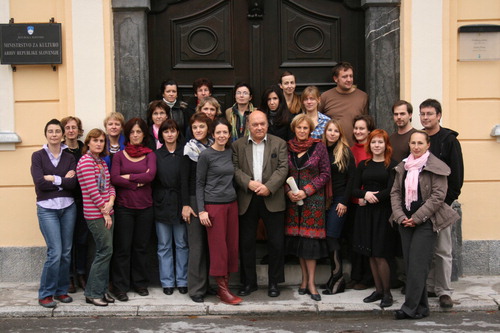
Participants were instructed on how to make models of sixteenth- and seventeenth-century limp vellum and paper bindings. The first week ended with a demonstration of the parchment making process at the workshop of Mr. Marjan Petač in Goričane near Ljubljana. We also had the privilege of hosting papermaker, Jacques Brejoux from Moulin Du Verger in Puymoyen near Angoulême, for two days. Mr. Brejoux has spent over the 30 years making hand-made paper based on pre-eigheenth-century techniques.
2010, November 8–19: an exemplar for stiff board binding
The last workshop concentrated on making a laced-on board binding that incorporated desirable qualities from a wide variety of stiff-board binding techniques.
Good quality binding structure relies on well-judged sewing, board shaping, endbanding and covering, and not on artificial spine, shaping, adhesives or pressing. Care and concentration are required, because in this binding there are few of the in-built tolerances so necessary for the post c.1550 binding trade, or for that matter for today's average bookbinder. To achieve this was hard work but by the end of the sessions I hope the participants have understood some of his basic constructional philosophy and some essential techniques that will greatly help them in their future studies. (Clarkson, Citation1997–Citation2010: year 2010) ()
Results and discussion
The first five workshops were jointly organized by the Archives of the Republic of Slovenia and the National and University Library in Ljubljana, the sixth workshop was organized solely by the Archives of the Republic of Slovenia and the last two in collaboration with the Conservation Department of the Academy of Fine Art and Design of the University of Ljubljana and the Slovenian Conservation Society. The workshop participants were conservators employed by the Archives of the Republic of Slovenia, the National and University Library and some students. The last two international workshops included conservators from Croatia, Czech Republic, Hungary, Lithuania, Italy, The Netherland, Serbia and Slovenia. Along with each workshop Clarkson gave a public lecture. The lectures were coordinated by Professor Nataša Golob, professor of Medieval Art History and Codicology at the University of Ljubljana. In July 2003, Christopher Clarkson also delivered a paper at the international conference, ‘Exhibiting Archival, Library Material and Works of Art on Paper and Parchment’ organized by the Archives of the Republic of Slovenia, entitled ‘The Permanent Display of the Single Parchment Membrane in Fluctuating Environmental Conditions; From Small Charter to the Mappa Mundi’ (Clarkson, Citation2004: 33–50).
In 2010, a week before his 72. birthday, still full of energy, Clarkson completed his eighth workshop and tenth working trip to the Book and Paper Conservation Centre of the Archives of the Republic of Slovenia in Ljubljana. Contact and collaboration with Christopher Clarkson continued for several years after his work in Slovenia ended. Research work, publications and other events connected to his workshops and book Conservation in Slovenia and Croatia abound. Here is a partial list of them.
‘Conservation of Giulio Clović painting on parchment’, Christopher Clarkson, 2010 four-day workshop, organized by the Croatian Conservation Institute in Zagreb.
Ligatus Summer School, Dr. Nicholas Pickwoad, Dr. Thanasis Velios and Dr. Georgios Boudalis, 2014, conference, Ljubljana (Ligatus, Citation2014).
Byzantine Bookbindings, Dr. Georgios Boudalis, 2014, organized by the Archives of the Republic of Slovenia.
Ligatus Summer School, 2015, organized by the Croatian State Archives in Zagreb (Ligatus, Citation2015).
‘Methods of protection of paper and book material’ Conference, Dedicated in Memoriam to Christopher Clarkson, 2017, organized by Iva Gobić Vitolović at the State Archives in Rijeka.
Medieval Bindings in Slovenia, 2000, published by the Archives of the Republic of Slovenia (Vodopivec Tomažič et al., Citation2000).
Binding Structures on Stiff-Board Manuscripts, 2000, published by the Archives of the Republic of Slovenia (Vodopivec Tomažič et al., Citation2000).
Book and Paper Conservation 2, 2016, published by the Archives of the Republic of Slovenia (Vodopivec Tomažič, Citation2016).
Bookbindings Theoretical Approaches and Practical Solutions, 2017, published by BREPOLS (Golob and Vodopivec Tomažič, Citation2017).
With Christopher Clarkson's knowledge several of his students from the Ljubljana programs earned diplomas: Jedert Vodopivec Tomažič, PhD, Blanka Avguštin Florjanovič, Andreja Dragojević and Iva Gobić Vitolović, MA diplomas from the University of Ljubljana.
Christopher Clarkson's work in the book conservation field continues to have enormous worldwide influence. Christopher Clarkson, despite his passing, continues to be acknowledged as a world-renowned expert on the conservation of archival and library materials. He conveyed an incredibly detailed theoretical and practical knowledge of the subject. We all agree with Clarkson's good friend and colleague, Dr. Nicholas Pickwoad, who wrote that Christopher Clarkson in his distinguished career, managed to develop and make practical the major guiding principles of theoretical and practical education in the area of book conservation, exhibition and the handling of books.
Clarkson's remarkable knowledge, extensive experience and his own engineering approach to the field of book conservation and preservation are unique. Many of his revolutionary approaches are often taken for granted by the younger generation of book conservators. Yet those approaches are the result of Clarkson's research and practices (Pickwoad, Citation2017). Clarkson's teachings, innovations and numerous publications also had a profound effect on understanding book structures. Throughout the years, Christopher, successfully imparted important book conservation philosophies based on understanding material science and book engineering techniques. These philosophies have moved the profession from one that destroyed historic bookbinding evidence to one that preserves history. Christopher Clarkson's students were transformed by learning his theories of book conservation, which still today are little-known concepts.
Acknowledgements
The book conservation training in Ljubljana was possible due to the initial, important support of Dr. Vladimir Žumer, Director of the Archives of the Republic of Slovenia We are also grateful for the deep understanding of Dr. Nataša Golob, codicologist and professor of medieval art history at the University of Ljubljana and her willingness to coordinate seminars. And finally, we are thankful for the enthusiastic, interested participants.
Additional information
Notes on contributors
Jedert Vodopivec Tomažič
Jedert Vodopivec Tomažič is professor of preservation of written heritage at the University of Ljubljana and Alma Mater Europaea ECM and head of the Book and Paper Conservation Department at the Archives of the Republic of Slovenia. She obtained her BSc and MSc degree in Chemistry Science and PhD degree in Conservation Science at the University of Ljubljana. After a short period working in a research laboratory, she joined the Conservation Department of the Archives of the Republic of Slovenia in 1980 as chemist and book and paper conservator working on archive, library and other graphic materials. In 1990 she became the head of the Conservation department. She is also involved in the professional training of conservators, arhivists and librarians. She has authored national and international papers, organized conferences, seminars and workshops on conservation of written and graphic cultural heritage and is collaborating on conservation of books and paper research projects.
References
- Bell, N. & Clarkson, C. 2001. Personal and Professional Reflections: A Conversation with Christopher Clarkson. The Paper Conservator, 25(1):71–84. doi: 10.1080/03094227.2001.9638683
- Clarkson, C. 1978. The Conservation of Early Books in Codex Form. A Personal Approach: Part 1. The Paper Conservator, 3(1):33–50. doi: 10.1080/03094227.1978.9638508
- Clarkson, C. 1982. Limp Vellum Binding and Its Potential as a Conservation Type Structure for the Rebinding of Early Printed Book. A Break with 19th and 20th Century Rebinding Attitudes and Practices. Hitchin: Michael Gullick at the Red Gull Press.
- Clarkson, C. 1997. The Safe Handling and Display of Medieval Manuscripts and Early Printed Books | Varno ravnanje s srednjeveškimi rokopisi in prvotiski in njihovo razstavljanje. In: J. Vodopivec & N. Golob, eds, Konserviranje knjig in papirja: zbornik razprav - Ljubljana, Julij 1996 | Book and paper conservation: Ljubljana, July 1996. Ljubljana: The Archives of the Republic of Slovenia, pp. 141–188.
- Clarkson, C. 1997–2010. Staff Training Programmes. Unpublished.
- Clarkson, C. 1999. Minimum Intervention in Treatment of Books. In: M.S. Koch, P. Regnault, & J. Palm, eds., S. Schröder and P. Regnault, trans. Preprints of the 9th International Congress of IADA, Copenhagen, August 15–21, 1999. Copenhagen: Royal Danish Academy of Fine Arts, School of Conservation, pp. 89–96. [accessed 27 October 2019]. Available at: <http://web.archive.org/web/20160222032401/https://www.iada-home.org/ta99_089.pdf>.
- Clarkson, C. 2004. The Permanent Display of the Single Parchment Membrane in Fluctuating Environmental Conditions: From Small Charter to the Mappa Mundi. In: Vodopivec Tomažič, ed. Exhibiting Archival and Library Material and Works of Art on Paper: Standards in Preservation. Ljubljana, 5–6 June 2003. Ljubljana: The Archives of the Republic of Slovenia, pp. 33–50.
- Clarkson, C. 2007. The Personal Development of Three Binding Techniques. In: J. Shulla, ed. Edinburgh Conference Papers 2006: Proceedings of the Fifth International Conference of the Institute of Paper Conservation and the First International Conference of the Institute of Conservation, Book and Paper Group 26–29 July 2006. London: Institute of Paper Conservation, pp. 87–96.
- Golob, N. 1998. Pogovor s prof. Christopherjem Clarksonom/ The Medieval book – A Discussion with Prof. Christopher Clarkson. Arhivi. Glasilo Arhivskega društva in arhivov Slovenije, 21(1–2):87–93.
- Golob, N. & Vodopivec Tomažič, J. 2017. Bookbindings: Theoretical Approaches and Practical Solutions. Turnhout: Brepols.
- Ligatus. 2014. Ligatus Summer School 2014. Archives of the Republic of Slovenia, Ljubljana, September 22–October 6, 2014. Ligatus Research Centre [accessed 22 February 2020]. Available at: <https://web.archive.org/web/20160725191132/http://www.ligatus.org.uk/summerschool/2014/course>.
- Ligatus 2015. Ligatus Summer School 2015. Croatian State Archives, Zagreb, September 7–17, 2015. Ligatus Research Centre [accessed 22 February 2020]. Available at: <http://web.archive.org/web/20160625030741/https://www.ligatus.org.uk/summerschool/2015/course>.
- Pickwoad, N. 2017. Obituary: Christopher Clarkson. International Institute for Conservation of Historic and Artistic Works [accessed 22 Sep 2019]. Available at: <https://web.archive.org/web/20180910170951/https://www.iiconservation.org/node/6977>.
- Planinc, L., Grkman, S., Višnikar, N. & Rahovsky Šuligoj, T. 2001. Izpopolnjevanje v specialnih tehnikah konservatorstva pod vodstvom prof. Christopherja Clarksona | Advanced training in special conservation techniques led by prof. Christopher Clarkson. Arhivi. Glasilo Arhivskega društva in arhivov Slovenije, 24(1):73–78.
- Vodopivec Tomažič, J. 2016. Konserviranje knjig in papirja 2 | Book and paper conservation 2. Ljubljana: The Archives of the Republic of Slovenia.
- Vodopivec Tomažič, J., Golob, N., Erjavec, M.V. & Kokalj, D. 2000. Vezave srednjeveških rokopisov: strukturne prvine in njihov razvoj | Medieval bindings in Slovenia: binding structures on stiff-board manuscripts. Ljubljana: The Archives of the Republic of Slovenia.
- Zor, M. & Clarkson, C. 2008. Interview with Christopher Clarkson. Mp3. Ljubljana: National Radio of Slovenia.

